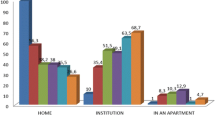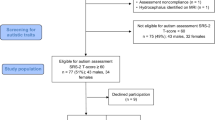Abstract
This study aimed to investigate the association of autistic regression (AR) and subtypes of AR with medical, developmental and psychiatric factors. Fifty-seven children with autistic spectrum disorders (ASD) were included in the study. Two types of AR are defined as regression after a normal social/language development (type 1) and regression as the worsening of previously reported autistic features (type 2). The frequency of history of AR was 56.1%. Male gender and sleep problems were found to be associated with a positive history of AR. The frequency of gastrointestinal complaints/diseases was higher in children with regression type 2 when compared to the children with regression type 1. Future studies with larger sample size and prospective design will contribute to clarifying the phenomenology and the associated factors of AR.
Similar content being viewed by others
References
American Psychiatric Association (2000) Diagnostic and Statistical Manual of Mental Disorders, 4th edn, Text Revision (DSMIV-TR). American Psychiatric Association, Washington DC
Tuchman R (2009) CSWS-related autistic regression versus autistic regression without CSWS. Epilepsia 50(Suppl 7):18–20
Hoshino Y, Kaneko M, Yashima Y et al (1987) Clinical features of autistic children with setback course in their infancy. Jpn J Psychiatry Neurol 41:237–245
Kobayashi R, Murata T (1998) Setback phenomenon in autism and long-term prognosis. Acta Psychiatr Scand 98:296–303
Kurita H (1985) Infantile autism with speech loss before the age of thirty months. J Am Acad Child Psychiatry 24:191–196
Canitano R, Luchetti A, Zappella M (2005) Epilepsy, electroencephalographic abnormalities, and regression in children with autism. J Child Neurol 20:27–31
McVicar KA, Shinnar S (2004) Landau–Kleffner syndrome, electrical status epilepticus in slow wave sleep, and language regression in children. Ment Retard Dev Disabil Res Rev 10:144–149
Baird G, Robinson RO, Boyd S et al (2006) Sleep electroencephalograms in young children with autism with and without regression. Dev Med Child Neurol 48:604–608
Baird G, Charman T, Pickles A et al (2008) Regression, developmental trajectory and associated problems in disorders in the autism spectrum: the SNAP study. J Autism Dev Disord 38:1827–1836
Davidovitch M, Glick L, Holtzman G et al (2000) Developmental regression in autism: maternal perception. J Autism Dev Disord 30:113–119
Goldberg WA, Osann K, Filipek PA et al (2003) Language and other regression: assessment and timing. J Autism Dev Disord 33:607–616
Siperstein R, Volkmar F (2004) Brief report: parental reporting of regression in children with pervasive developmental disorders. J Autism Dev Disord 34:731–734
Shinnar S, Rapin I, Arnold S et al (2001) Language regression in childhood. Pediatr Neurol 24:183–189
Tuchman RF, Rapin I, Shinnar S (1991) Autistic and dysphasic children. I: Clinical characteristics. Pediatrics 88:1211–1218
Tuchman RF, Rapin I (1997) Regression in pervasive developmental disorders: seizures and epileptiform electroencephalogram correlates. Pediatrics 99:560–566
Ozonoff S, Williams BJ, Landa R (2005) Parental report of the early development of children with regressive autism: the delays-plus-regression phenotype. Autism 9:461–486
Richler J, Luyster R, Risi S et al (2006) Is there a ‘regressive phenotype’ of Autism Spectrum Disorder associated with the measles-mumps-rubella vaccine? A CPEA Study. J Autism Dev Disord 36:299–316
Rogers SJ (2004) Developmental regression in autism spectrum disorders. Ment Retard Dev Disabil Res Rev 10:139–143
Wiggins LD, Rice CE, Baio J (2009) Developmental regression in children with an autism spectrum disorder identified by a population-based surveillance system. Autism 13:357–374
Richdale AL (1999) Sleep problems in autism: prevalence, cause, and intervention. Dev Med Child Neurol 41:60–66
Malow BA, Marzec ML, McGrew SG et al (2006) Characterizing sleep in children with autism spectrum disorders: a multidimensional approach. Sleep 29:1563–1571
Cortesi F, Giannotti F, Ivanenko A, Johnson K (2010) Sleep in children with autistic spectrum disorder. Sleep Med 11:659–664
Giannotti F, Cortesi F, Cerquiglini A, Miraglia D, Vagnoni C, Sebastiani T et al (2008) An investigation of sleep characteristics, EEG abnormalities and epilepsy of developmentally regressed and non-regressed autistic children. J Autism Dev Disord 38:1888–1897
Giannotti F, Cortesi F, Cerquiglini A, Bernabei P (2006) An open-label study of controlled release melatonin in treatment of sleep disorders in children with autism. J Autism Dev Disord 36:741–752
Krug DA, Arick J, Almond P (1980) Behavior checklist for identifying severely handicapped individuals with high levels of autistic behavior. J Child Psychol Psychiatry 21:221–229
Yılmaz-Irmak T, Tekinsav Sütçü S, Aydın A et al (2007) Otizm davranış kontrol listesinin geçerlik ve güvenilirliğinin incelenmesi. Çocuk ve Gençlik Ruh Sağlığı Dergisi 14:13–18 (Article in Turkish)
Aman MG, Singh NN, Stewart AW, Field CJ (1985) The aberrant behavior checklist: a behavior rating scale for the assessment of treatment effects. Am J Ment Defic 89:485–491
Karabekiroglu K, Aman MG (2009) Validity of the aberrant behavior checklist in a clinical sample of toddlers. Child Psychiatry Hum Dev 40:99–110
Schopler E, Reichler RJ, DeVellis RF, Daly K (1980) Toward objective classification of childhood autism: Childhood Autism Rating Scale (CARS). J Autism Dev Disord 10:91–103
Aşan IF, Türe S, Gökçay A, Karasoy H (2006) Tuberoskleroz Kompleksi ve Otizm. J Neurol Sci 23:312–317 (Article in Turkish)
Savaşır I, Sezgin N, Erol N (1998) Ankara Gelişim Tarama Envanteri. 3. Basım. Türk Psikologlar Derneği Yayınları, Ankara (Article in Turkish)
Savaşır I, Şahin N (1995) Wechsler Çocuklar İçin Zeka Ölçeği (WISC-R) El Kitabı. Türk Psikologlar Derneği Yayınları, Ankara (Article in Turkish)
Bernabei P, Cerquiglini A, Cortesi F, D’Ardia C (2007) Regression versus no regression in the autistic disorder: developmental trajectories. J Autism Dev Disord 37:580–588
Lord C, Shulman C, Dilavore P (2004) Regression and word loss in autistic spectrum disorders. J Child Psychol Psychiatry 45:936–955
Krakowiak P, Goodlin-Jones B, Hertz-Picciotto I, Croen LA, Hansen RL (2008) Sleep problems in children with autism spectrum disorders, developmental delays, and typical development: a population-based study. J Sleep Res 17:197–206
Erickson CA, Stigler KA, Corkins MR, Posey DJ, Fitzgerald JF, McDougle CJ (2005) Gastrointestinal factors in autistic disorder: a critical review. J Autism Dev Disord 35:713–727
Taylor B, Miller E, Lingam R (2002) Measles, mumps and rubella vaccination and bowel problems or developmental regression in children with autism: population study. Br Med J 324:393–396
Conflict of interest
None.
Author information
Authors and Affiliations
Corresponding author
Rights and permissions
About this article
Cite this article
Ekinci, O., Arman, A.R., Melek, I. et al. The phenomenology of autistic regression: subtypes and associated factors. Eur Child Adolesc Psychiatry 21, 23–29 (2012). https://doi.org/10.1007/s00787-011-0228-7
Received:
Accepted:
Published:
Issue Date:
DOI: https://doi.org/10.1007/s00787-011-0228-7




